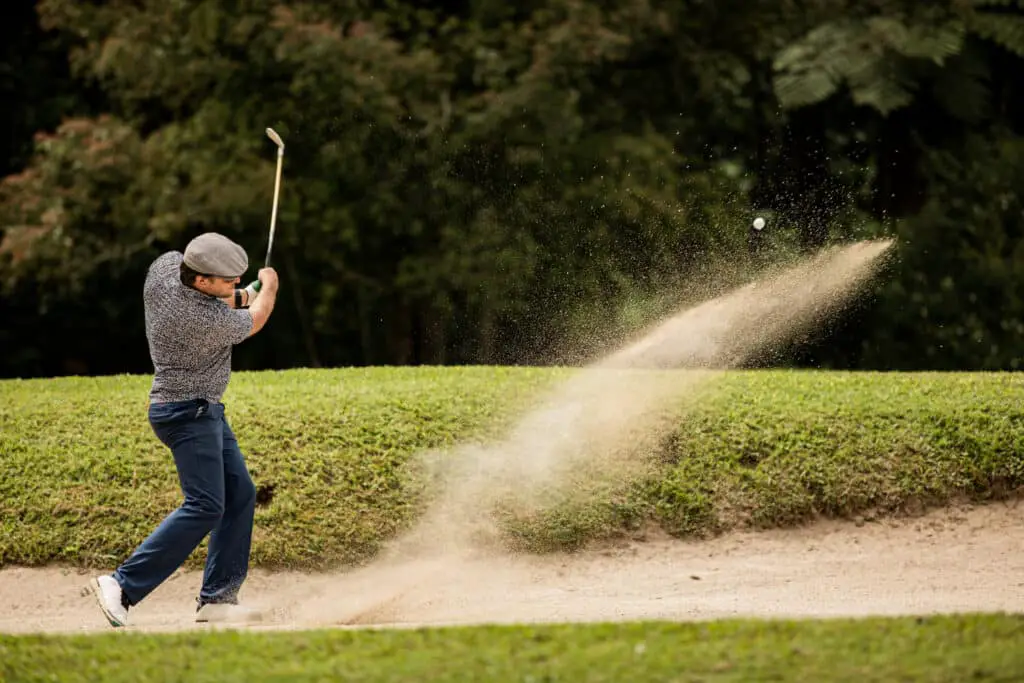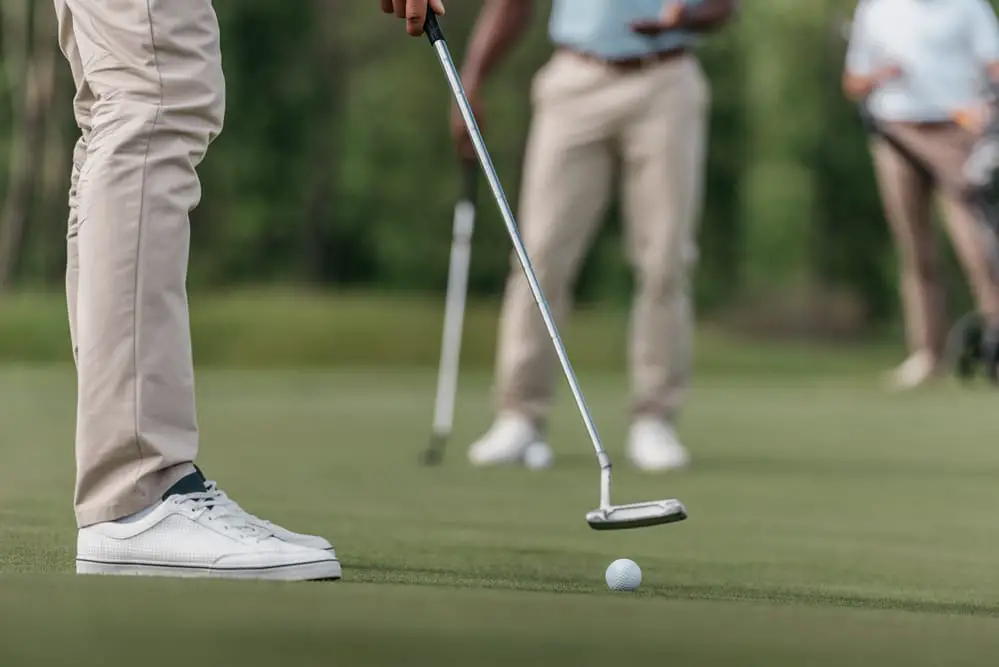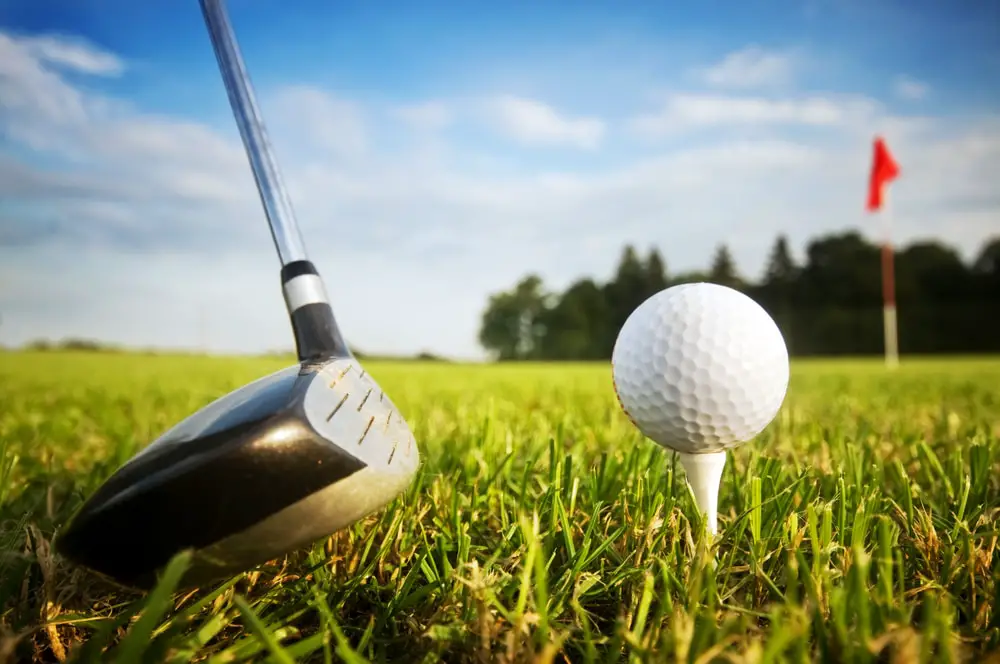Last Updated on June 6, 2023
Golf is one of the most popular sports worldwide. It requires skill, strategy and concentration to achieve success in the course. One common issue golfers experience is hitting the ball into the ground instead of off it. This can be incredibly frustrating for players as their shots fall short of where they expected them to go. Investigating this issue further will uncover possible explanations for why a golfer’s shot does not reach its intended destination.
This article aims to explore what potential causes may lead to a player consistently hitting the golf ball into the ground, preventing it from making contact with air and reaching full flight trajectory. It will also assess how these issues can be addressed in order to improve performance and accuracy when playing golf. By addressing these underlying problems, golfers are more likely to make better decisions on the course leading to an improved game overall.
Causes Of Ground Striking
Ground striking is a common issue faced by many golfers, as it can result in less distance and inaccurate ball flight. Poor contact with the ground is typically caused by certain issues with the swing, such as incorrect technique or poor posture. In order to reduce ground striking, golfers must be aware of the underlying causes that may lead to such an occurrence.
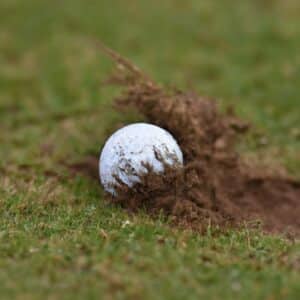
There are several potential causes of ground strikes which include technical flaws, improper setup and ball positioning, faulty equipment, and inadequate practice. Technical flaws refer to errors in the golfer’s form during their backswing and downswing; this includes improper grip pressure, clubface alignment at address, weight distribution throughout the swing, and other components of the technique. Improper setup and ball positioning can also contribute to hitting shots into the ground due to misalignment between the body and target line when addressing the ball. Additionally, using ill-fitting or outdated clubs will increase one’s chances of experiencing consistent ground strikes since they may have unfavourable lofts or lie angles for a particular player’s stance or set up. Finally, an insufficient practice could cause players to struggle with correctly coordinating all necessary elements in their swings resulting in failure to make ideal contact with the ball itself.
Therefore, recognizing what factors influence ground striking is essential if golfers wish to improve their performance. Identifying these sources requires careful observation while playing rounds and taking lessons from experienced instructors who can offer advice on how best to correct any shortcomings within a golfer’s game.
Posture And Alignment
Posture and alignment are fundamental to ensure the correct technique when hitting a golf ball. Poor posture or incorrect body alignment can cause you to hit the ball into the ground. To avoid this, it is essential that your feet are shoulder-width apart in an open stance, with toes slightly pointing outward. This will help keep your centre of gravity balanced while increasing power during the swing.
Grip pressure should be light but firm so as not to disrupt the natural flow of motion whilst swinging. Keeping arms relaxed helps maintain optimal flexibility throughout your backswing, which allows for greater control over the clubface angle at impact. Additionally, having a proper head position and keeping your eyes focused on the target helps prevent overextending and misaligning your body before striking the ball. All these aspects combined create a sturdy foundation to execute a successful shot each time.
Clubface Angle At Impact
After reviewing the importance of posture and alignment in a golf swing, the next crucial element is the clubface angle at impact. The angle variation between the clubface relative to its intended target line has an immense influence on the outcome of an individual shot. Understanding how this factor affects ball flight will help players develop better control over their shots and make necessary adjustments along the way.
To properly address the clubface at impact, it is essential to consider two components:
- Swing Plane: This refers to the path that the clubhead follows during a swing and describes whether or not it is square with respect to its starting position. It must be noted that even if your swing plane is correct, improper angling can still occur due to incorrect hand movement through impact. Therefore, it is important for players to focus on both aspects when trying to optimize their accuracy off the tee box.
- Clubface Squareness: Once you have established an appropriate reference point from which to measure clubface angle (e.g., ball-to-target line), evaluating whether or not it remains ‘square’ throughout contact becomes much easier. By maintaining constant angles from start to finish, any deviations from proper mechanics can easily be identified and corrected accordingly.
Golfers should also pay close attention to variations in their impact angles depending on shot type; for example, drivers typically require more loft than irons due to differences in weight distribution within each respective club head design. Taking all these variables into account will ensure consistent results regardless of what clubs are being used out on the course.
Swing Path
A golfer’s swing path, or the angle at which they approach the golf ball, can cause a variety of issues when hitting. Poor swing direction and alignment will often result in the club head striking into the ground prior to contact with the golf ball. To correct this issue, it is important for a player to adjust their swing plane so that it is more parallel with the target line. This adjustment will help ensure a better contact with the ball rather than impacting the ground first.
In order to improve one’s swing path, there are numerous drills available that can be done on and off the course. A common drill used to practice proper swing-path correction is known as ‘the gate drill’. This requires two tees placed just outside each side of where your feet would normally stand at the address position; these represent an imaginary ‘gate’ between them. The goal then becomes swinging through this gate without touching either tee, thus reinforcing proper swing-path technique during each shot taken by a golfer. With enough practice and understanding of how to correctly align oneself before taking a shot, this helps create consistency in every drive and iron shot made from any distance on both fairway and green surfaces alike.
Clubhead Speed
Clubhead speed is an important factor in golf that can impact the trajectory and distance of a ball. It is defined as the velocity at which the clubhead travels during a swing, and by increasing it one can increase their ability to hit farther and higher. Clubhead velocity should be maximized for maximum distance on each shot, so understanding how to achieve this is essential for any golfer.
| Swing Speed | Clubhead Momentum |
|---|---|
| 90 mph | 81 kgm/s |
| 100 mph | 121 kgm/s |
| 110 mph | 162 kgm/s |
| 120 mph | 204 kgm/s |
| 130 mph | 246 kgm/s |
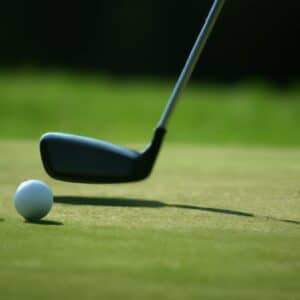
The table above shows the relationship between swing speed and corresponding clubhead momentum generated when hitting a drive with a 1-iron. As seen here, there is a linear relationship between these two measures – increasing your swing speed will result in increased clubhead momentum, allowing you to hit longer drives than before.
Improving your swing speed requires practice and dedication; however, certain techniques, such as making sure to keep your head still during your backswing or using correct grip pressure, can help optimize it over time. Additionally, learning from professional players who have mastered the technique may provide helpful insights into improving your own game. Therefore, understanding how to maximize your clubhead speed through proper technique is key for successfully driving off the tee box.
Ball Position In Stance
When it comes to hitting the golf ball, having the correct stance is essential for a successful shot. Ball position in relation to the stance will affect both the direction and impact of the ball. There are four main elements that must be considered when positioning the ball:
- Stance width – The farther away from your body you place the ball, the more difficult it becomes to make contact with an object at its centre; conversely, placing the ball too close increases the chances of mishitting or topping it.
- Stance angle – If your feet are parallel with each other and pointing straight ahead, then your shoulders should naturally line up perpendicular with them. This ensures that your weight is evenly distributed throughout your swing.
- Ball direction – Your feet should point towards where you want to hit the golf ball; if they do not, adjust accordingly so that your swing path follows suit.
- Ball impact – Positioning the ball further back in your stance promotes a downward strike on impact, which helps avoid over-hitting/hooking shots into hazards or out-of-bounds areas.
It is important to spend time experimenting with different positions and stances until ultimately finding one that works best for you and allows consistent results in every round of play. With practice, this can give players confidence as they take their swings, knowing they have set themselves up correctly for success.
Tee Height Adjustment
The tee height is a critical element of the golf swing that can significantly influence the flight and trajectory of the ball. Making adjustments to the tee height may not be necessary for every golfer, but it should certainly be considered if the player notices their shots are consistently hitting the ground. Tee height changes, alterations, variations or modifications may help to reduce this occurrence by helping to lift the ball off from its lie more easily on impact.
Generally speaking, adjusting one’s tee-height will depend largely on personal preference and skill level. For instance, recreational players with lower clubhead speeds may benefit from boosting their tee-height while experienced players with higher club head speeds may need to lower theirs. In either case, these small tweaks in tee-height could potentially result in improved performance when addressing the ball at address as well as greater consistency overall.
Loft And Lie Of The Clubhead
One of the key factors that can determine why a golfer is hitting the ball into the ground is due to the loft and lie of the clubhead. Loft refers to the angle formed between the shaft and face of the club, while lie refers to how much vertical or horizontal tilt is present in relation to the sole. The combination of these two angles is what determines where an impact, if any, will occur with respect to the golf ball when striking it.
| Loft Angle | Lie Angle | |
|---|---|---|
| 1 | 9°-12° | 60° |
| 2 | 13°-20° | 59.5° |
| 3 | 21°-26° | 59° |
| 4 | 27+ | 58.5 – 58° |
The table above shows how various lofts and lies correspond with each other in order for a golfer to make proper adjustments based on their individual needs and playing style. If either of these angles is too low or high, then this can have an adverse effect as far as striking below centre on a golf ball which could result in hitting into the ground more often than desired. It is important for anyone who encounters this problem to analyze both angles individually before trying to adjust them accordingly.
Therefore, understanding and adjusting loft and lie angles correctly can help ensure success at making contact above the centre with every swing; thus preventing misdirected shots that may lead to hitting into the ground too often.
Influence Of Course Conditions
Course conditions can have a major influence on the direction and trajectory of a golf ball. Golf courses vary widely in terrain, from flat fairways to undulating hillsides with steep slopes and deep roughs. The natural characteristics of the course, such as wind speed, elevation changes, and slope within the fairway or green area, will all contribute to how a golfer may hit their shot. In addition to these elements, other variables, such as green speed, are important when assessing why one is hitting into the ground.
The combination of these various factors creates an environment that requires careful consideration for each individual shot taken. If a golfer does not take into account all course conditions when preparing for a shot, then they may be more likely to put themselves at risk of mis-hitting due to unforeseen circumstances such as increased wind speeds or uneven turf. It is, therefore, essential that golfers assess their surroundings before every swing so they can adjust accordingly and make effective decisions while playing.
Effect Of Unlevel Lies
Having discussed the influence of course conditions on ball trajectory, it is now time to explore how unlevel lies can affect a golfer’s ability to hit the ball. Unlevel lies refer to any lie where the ground angle and/or the lie angle are not level with one another. This can have significant implications for a golfer’s swing plane and, ultimately, their ball trajectory. The following points should be considered when attempting a shot from an unlevel lie:
- Grip adjustments: Depending on which way you need to adjust your grip in order to compensate for the slope, it will determine if you need more or less hand pressure applied during your swing.
- If adjusting your grip requires rotating your hands clockwise (as viewed from above), then extra hand pressure must be applied at the address so that this rotation does not occur throughout the swing.
- Conversely, if counterclockwise rotation is necessary, then additional hand pressure must also be taken away at the address; otherwise, there could be too much clubface rotation happening through impact.
- Weight distribution: When hitting shots from an uneven surface, weight distribution becomes key as it determines how far up or down hill you’re able to successfully strike the golf ball while maintaining balance and control over your swing. As such, try shifting most of your weight onto whichever foot allows you better access to the golf ball, depending on whether it’s uphill or downhill; this will help ensure that you’re able to maintain good body positioning throughout all stages of your setup and backswing motion.
By understanding how these two elements interact with each other – namely grip adjustment and weight distribution – players can optimize their chances for success when faced with an unlevel lie situation out on the course. With careful consideration given towards both components prior to executing a shot from an off-balance lie, golfers may find themselves pleasantly surprised by just how well they manage to get the job done!
Frequently Asked Questions
What Is The Most Common Cause Of Ground Striking?
Ground striking is a common issue among golfers, referring to when the ball is hit into the ground before reaching its intended target. Understanding the most frequent causes of this problem can help players address their weaknesses in order to improve accuracy and distance.
One of the leading reasons for ground striking is an incorrect setup at address position. When taking aim before hitting the ball, it is important that the body be properly aligned with shoulders facing directly towards the target and feet shoulder-width apart. If any part of one’s stance deviates from its proper form, it may result in poor contact with the ball as well as a misdirection of shots. Additionally, an improper grip on the club will lead to decreased control over where each shot goes; instead of sending it straight ahead, you could see shots veering off direction or sinking down too soon due to a lack of power generated by the hands and arms. Finally, using clubs that are either too long or too short for your height can also contribute to ground striking since they do not allow for ideal swing path motion, which would generate enough force behind every strike resulting in increased carry and distance travelled by each shot.
Understanding these key elements can enable golfers to identify what areas they need improvement in order to reduce instances of ground strikes while playing rounds. With practice and dedication, players should be able to better master their technique over time, allowing them more consistent performance across all courses.
What Role Does A Golf Coach Play In Helping Improve Ground Striking?
A golf coach plays an important role in helping a golfer improve their ground striking. Through swing adjustments, the coach can help adjust the clubface angle to ensure optimal contact with the ball on different types of lies. This is beneficial for improving accuracy and distance control.
Below are 3 key elements that a good golf coach should consider when assisting a golfer in achieving better ground strikes:
- Accurate assessment of lie type – Understanding how the slope or terrain affects where the ball ends up is essential for proper strike adjustment.
- Adjustment of clubface angle – A change in loft and face angle during set up can greatly influence whether a shot will be successful or not.
- Swing timing and mechanics advice – Proper technique requires coordination between body position, grip pressure, tempo and follow through; all these need to be adjusted as per each situation.
Having an experienced golf coach who understands how to make necessary changes based on specific situations will enable players to achieve consistent results even with challenging lies. Ultimately, this leads to improved confidence on course which reflects in improved scores over time.
Conclusion
Understanding why one hits into the ground is essential in finding solutions that will lead to better performances on the course. The knowledge gained through recognizing common causes and potential remedies associated with ground striking provides players with valuable insight into their game which they can apply for years to come.
